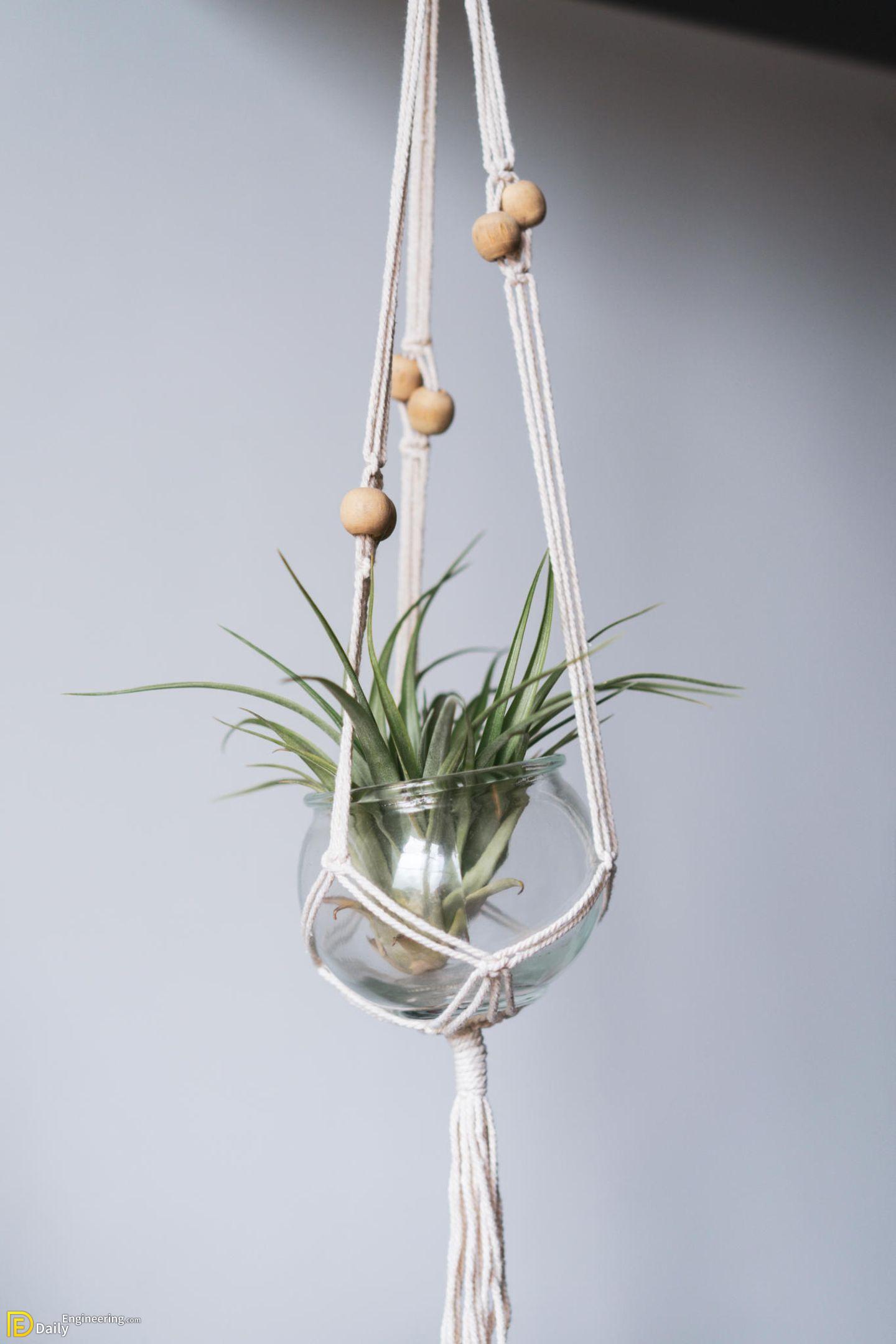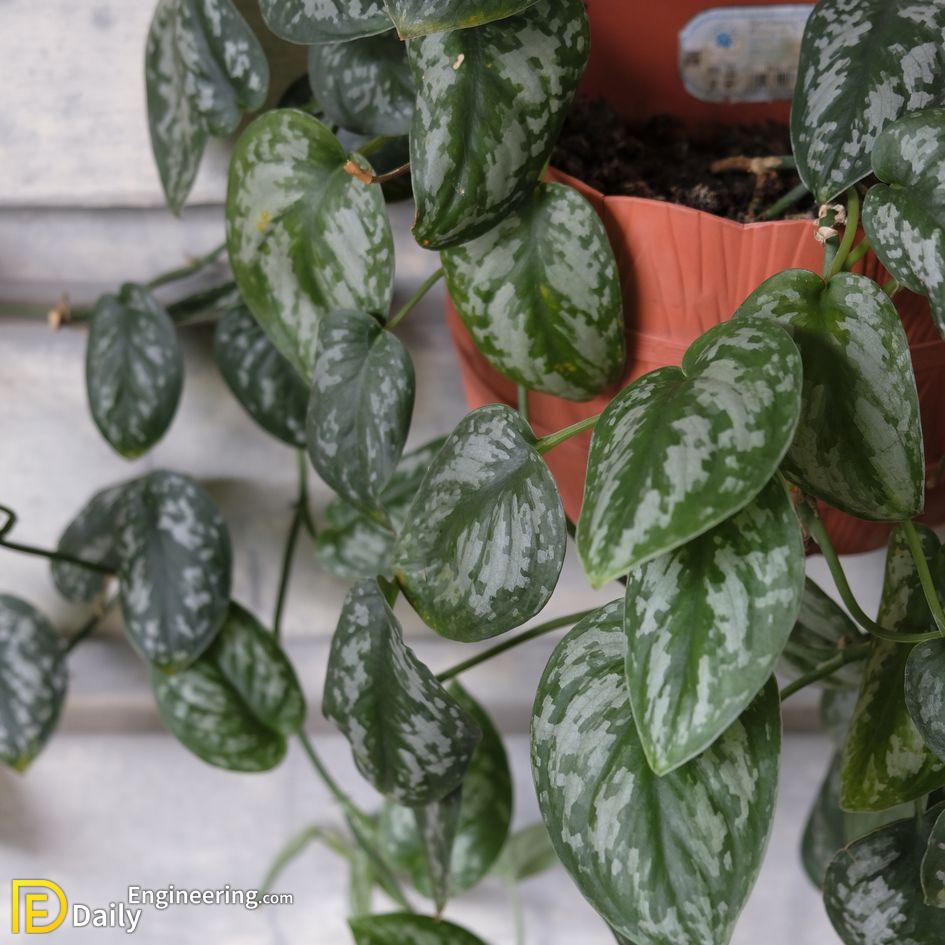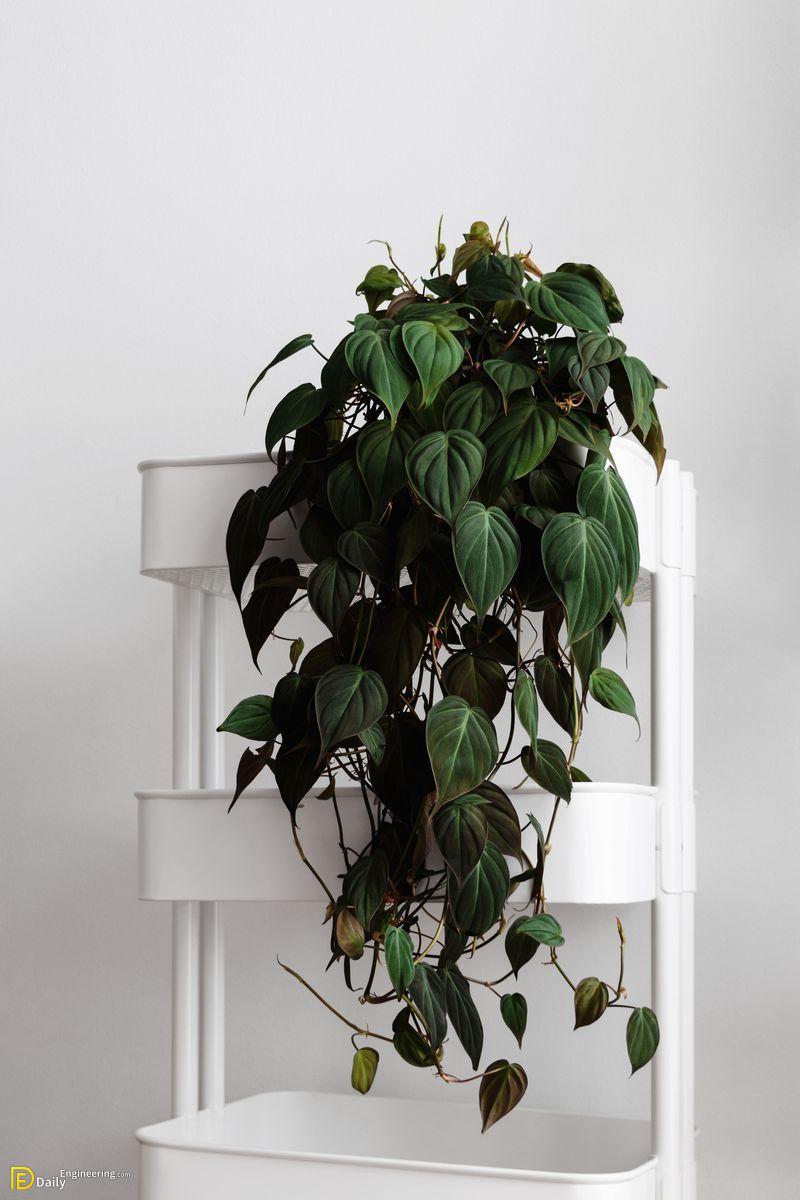1. Tillandsia (Air Plant)

- Botanical Name: Tillandsia
- Sun Exposure: Bright, indirect light
- Soil Type: Epiphytic
- Soil pH: 4.0 to 8.0 (Water pH)
Tillandsia, commonly known as air plants, are an especially great choice to create a hanging plant wall in your space. These unique houseplants can be used for interior decorating in many ways, thanks to their ability to grow on any surface.
“Air plants are a unique pick for a hanging plant because they do not require potting mix to grow,” Satch says. Simply attach your air plants to a hanger of your choosing, and spritz them with water once a week to ensure the proper level of moisture.
“Hang them by a string, or [place them] inside a hanging globe—just make sure it has a large hole for air to circulate. Air plants require bright, indirect light and weekly water. Keep humidity high by misting between waterings,” he notes. “Also, this houseplant is pet-friendly!”
2. Bird’s Nest Fern

- Botanical Name: Asplenium nidus
- Sun Exposure: Medium indirect light
- Soil Type: Well-draining potting mix
- Soil pH: 5.0 to 5.5
Bird’s nest ferns earned their name for growing high in the trees of their native jungle environments. This species makes an excellent hanging plant indoors because of its growth habit, characterized by leaves with rippled edges that grow from a central bunch. Depending on the variety you choose, your bird’s nest fern will either grow upward toward the sun or in long, trailing leaves that cradle its pot.
To hang a bird’s nest fern in your home, find a place with indirect light that doesn’t get direct sun. “It prefers a little extra humidity, making it a great pick for a bathroom with a window think instant spa-like vibes,” Satch notes. “It does well in low to medium light, watered weekly.”
3. Peperomia

- Botanical Name: Peperomia
- Sun Exposure: Bright, indirect sunlight
- Soil Type: Cactus or succulent mix
- Soil pH: 5.0 to 6.0
Commonly known as radiator plants, the hundreds of variants that make up the Peperomia genus are a favorite pick by designers and plant specialists because of their attractive shape and easy-to-grow nature. “Its round, fleshy leaves help keep in water, so it can go a few more days without water than its parent plants,” Satch says. “I like how it looks like it’s reaching for the sun.”
After planting your peperomia in a hanging pot, you can place it in those areas where your high-maintenance plants won’t work—this species doesn’t require much attention to thrive. It’s also a pet-friendly plant, so it’s okay to hang at lower levels of the house.2
“This plant requires medium indirect light to dappled sun, but it can tolerate low light,” Satch says. It’s a great candidate for those north- and east-facing windows that don’t receive much sun exposure.
4. Silver Philodendron

- Botanical Name: Scindapsus pictus
- Sun Exposure: Bright, indirect light
- Soil Type: Well-draining potting mix
- Soil pH: 5.1 to 6.5
“Often called a silver philodendron, this trailing plant is characterized by its wiry vines and dark green leaves with silver splotches,” Satch says. Unlike its all-green variant, the Scindapsus pictus can feature large sections of silver on its leaves. Depending on your specific plant, it can grow to maturity with a hybrid of both colors or with a predominantly silver color.
“In the wild, the leaves can be found sprawled out along the ground and climbing up trees,” Satch says. “They can gracefully trail down from a hanging planter.” He recommends finding a place for this plant in your home with medium-light—likely near an east-facing window—and watering weekly.
5. Marble Pothos

- Botanical Name: Epipremnum aureum
- Sun Exposure: Medium indirect light
- Soil Type: Well-draining potting mix
- Soil pH: 6.1 to 6.5
Known for their lush vines, the marble pothos is very simple to care for. Without sacrificing style, this species needs relatively little attention to grow into long, trailing lengths in your home. “This plant is characterized by its variegated leaf and hardy, climbing vines,” Satch says. “This is a great choice for beginners since it can be easily propagated by stem cuttings.”
To create a new plant from your marble pothos, simply cut one healthy stem with a few leaves and place it in water—you’ll have a second pothos ready to root in no time to fill your hanging wall.
To hang this plant, Satch recommends finding a place with average sun exposure (even those darker corners of your home). “They do well in low to medium light, watered weekly,” he notes. “It can tolerate lower light levels than most common houseplants.”
6. Staghorn Fern

- Botanical Name: Platycerium
- Sun Exposure: Bright, indirect light
- Soil Type: Epiphytic
- Soil pH: 6.1 to 6.5
Since this species naturally grows off the ground in nature (like the bird’s nest fern), the staghorn fern is a great candidate to hang indoors with the right light exposure. “The staghorn fern is epiphytic—it grows hanging on the sides of trees in nature! You often see these mounted on wooden plaques, and hung or planted in a sleek planter,” Satch says.
To hang your staghorn fern, you’ll want to find a place in your home that gets plenty of suns. “These are perfect for kitchens and bathrooms,” Satch says. “Bright light will cause them to grow their beautiful characteristic antler-like fronds,” Satch adds that they’re pet-friendly, too.
7. String of Hearts

- Botanical Name: Ceropegia woodii
- Sun Exposure: Bright, indirect light
- Soil Type: Cactus or succulent mix
- Soil pH: 6.0 to 7.5
Not to be confused with a string of pearls, the string of hearts species grows in a similar trailing vine. It’s one of Satch’s favorite Insta-worthy succulents because its leaves reflect its name: This plant’s thin stems and lush leaves are comparable to a garland of hearts. However, it doesn’t require the same care as many other similar varieties—a string of hearts is a bit of a hybrid succulent because of its water and soil needs.
“They’re a little more tricky to take care of since they need to be watered more often than other succulents, but don’t like to sit in water,” Satch says. “They should be soaked in a container with drainage.” Plant your string of hearts in cactus and succulent soil, or mix standard soil with sand and perlite to keep this species healthy.
8. Orchids

- Botanical Name: Orchidaceae
- Sun Exposure: Bright, indirect light
- Soil Type: Orchid bark and sphagnum moss blend
- Soil pH: 5.5 to 6.5
Satch recommends using Cattleya orchids or Vanda orchids in hanging planters. They can also be grown on a stick inside the pot, and thrive in full sun indoors. Find a south-facing window to hang your orchid for the best results (a west-facing window will also let in strong rays of the afternoon sun).
Satch enjoys hanging Cattleya orchids next to bright windows. “Their unique shapes are sure to spark interest in anyone who visits. The added bonuses? They bloom fragrant flowers, and they’re pet-friendly,” he says. Vanda orchids, on the other hand, are similar to air plants in their lack of soil needs: Unlike the Cattleya, their roots can grow bare. “These are the plants for over-waterers, as you must water them daily. Enjoy their roots that dangle like beaded curtains and their blooms once a year.”
Orchids on a stick are likely to require more attention than others. “However, they are still plants, and they’re not that difficult when you figure them out,” Satch says. “Generally, mist them once a day and soak them once a week.” If your orchids are getting full sun, he recommends soaking them twice a week to ensure water needs are met. “They all flower, and some have unique shapes and patterns found nowhere else in the plant kingdom.”
9. Philodendron

- Botanical Name: Philodendron
- Sun Exposure: Medium indirect light
- Soil Type: Well-draining potting mix
- Soil pH: 5.5 to 6.0
Another favorite species for beginner gardeners is the philodendron: a deep green, trailing ivy that requires little attention to grow its best. These plants are great to hang in higher areas of the house: With a few simple care steps, your philodendron can grow up to 20 feet long over time. In the first few years, a small philodendron will likely reach about four to five feet long.
Like the marble pothos, this species only needs medium indirect light. Since it’s able to thrive in various amounts of sunlight, your plant’s watering needs will depend on the exposure it receives. If your philodendron is close to a south- or west-facing window, you’ll need to water it more often than in the shadier windows of your home.
10. Jade Pothos

- Botanical Name: Epipremnum aureum
- Sun Exposure: Medium indirect light
- Soil Type: Well-draining potting mix
- Soil pH: 6.1 to 6.5
Jade pothos, known as Devil’s Ivy, is also a great choice for a low-maintenance indoor plant. Since this species can be trained to grow along a trellis, window frame, or household furniture, pothos is often used by interior designers to create a trailing look that complements a room’s décor.
With a bit of moderate light, your pothos can actually reach 40 feet long over time—so it’s a plant that can flourish in your home for years to come. This variant of the marble pothos features deep-green leaves (without any white marbling) which grow hardily toward the sunlight. Place your pothos in an east- or north-facing window, or even in shadier areas inside that aren’t suited for your other plants. This easy-to-grow species only needs moderate water every few weeks.

















